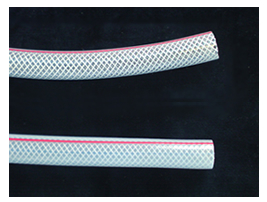Hose and Coupling Knowledge Base
If You Register to Become a Web Member, We Will Send You the Latest Information on Hoses and Coupling.
Can PVC & Other Plastic Hoses Be Used for Fuel Gas & Kerosene?

Our hearts go out to all of those who suffered in the 2011 Sendai earthquake and tsunami and their families. We pray for a quick recovery. Recovery of lifelines has been extraordinarily difficult in the aftermath of the quake, and it appears that considerable time will be needed until water and gas services can be restored. People continue to handle heaters in shelters as the bitter cold continues.
This topic is concerned with fuel and plastic hoses. Although hoses for water spraying, air and chemicals are made out of many different materials, those for fuel gas and kerosene are almost all made out of rubber. Can PVC and other plastic hoses be used for fuels and gas?
In short, the answer is no, they cannot.
Japanese Industrial Standard JISK6347, however, does establish rubber as a material for liquefied petroleum gas (including natural gas) for general households and equipment.
The Fire Service Law provides stipulations for kerosene, which depend on the volume involved.
For large-volume industrial use, basically only metal pipes are allowed, although fire stations have the authority to authorize use in small quantities, such as in the home. The standard used by fire departments make these determinations require authorization from the Hazardous Materials Safety Techniques Association. Because of the expense and traceability requirements for obtaining such authorization, it is not practical to do so.
Due to the nature of PVC and other plastics as well, they are not well suited to use for fuel gas or kerosene. PVC and other plastics deform easily in high temperature environments, and may leak or rupture. Also, the plasticizers used to maintain the flexibility of PVC melt in the presence of oil, making the hose stiff. If this happens and the hose is forced to bend, the reinforcing threads may break or the hose crack, leading to leaks or burst.
In terms of safety, plastic has a larger space between chemicals than rubber, so when a gas with small molecules such as liquefied petroleum gas is transported in a plastic hose, the gas molecules may penetrate through the hose. Such a leak is dangerous, and so plastic hoses may not be used for fuel gas. Always use a specialized hose for such purposes.
Archive
How to Cut Steel-Wire-Reinforced PVC Hose
Does Electricity Conservation Increase Condensation?
Why Do Hoses Leak & Disconnect?
Can PVC & Other Plastic Hoses Be Used for Fuel Gas & Kerosene?
How to Read Catalog Specifications, Part 4 – Are Hose Sizes Random?
How to Read Catalog Specifications, Part 3 – Minimum Bend Radius
Beware of Static Electricity on Hoses
How to Read Catalog Specifications, Part 2 – Negative Pressure+B10
About REACH, RoHS, Endocrine Disruptor & the Food Sanitation Act
How to Read Catalog Specifications, Part 1 – Use Pressure
How to Avoid Damage Caused by Ultraviolet Rays
The Dangers of Hose Condensation
Why Transparent Hoses Become Cloudy
Leaks & Disconnections Due to Mismatched Couplings & Hoses
Causes & Solutions for Leaks & Disconnections
The Benefits of the Right Hose for the Situation (2)









